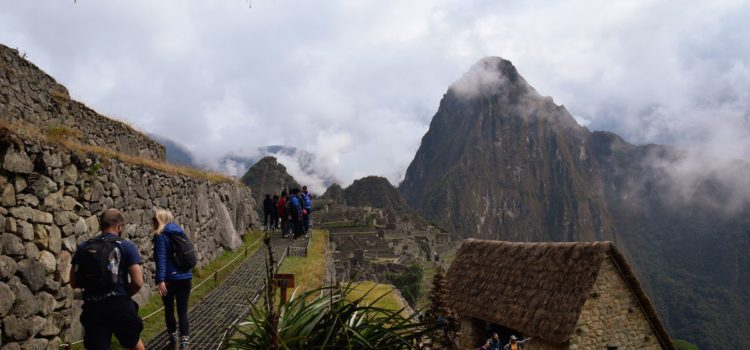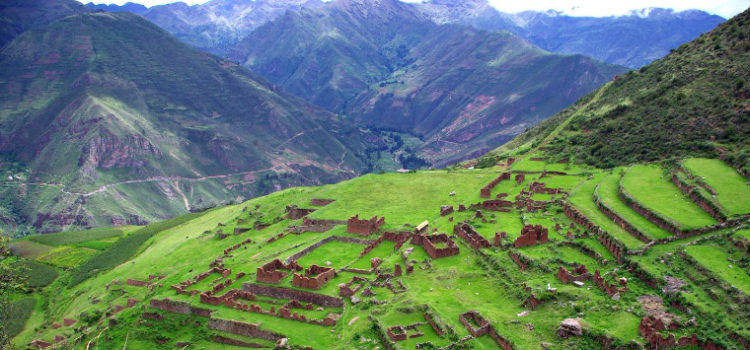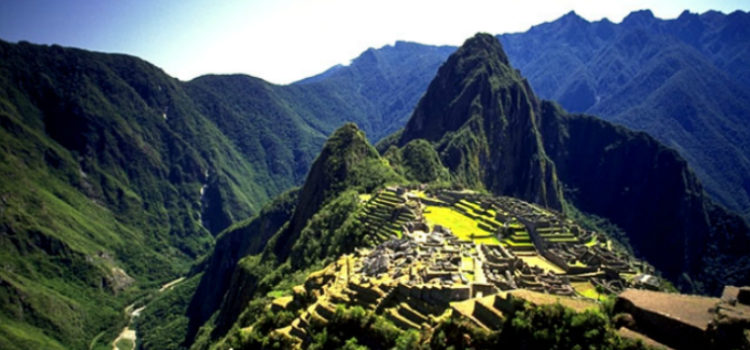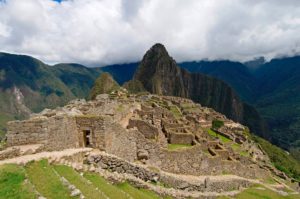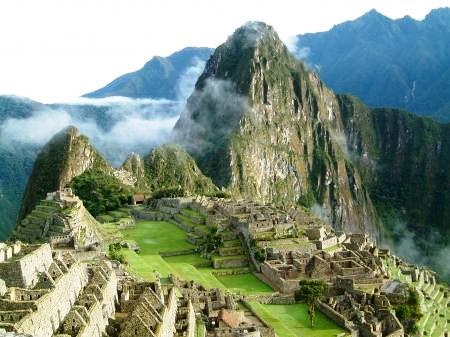How to get to Machu Picchu…
How to get to Machu Picchu…
In 2007 this beautiful Inca Citadel was nominated as one of the new Seven Wonders of the World. Each year one million visitors come to Cusco to visit the colonial city but their main purpose is to travel to their final destination of Machu Picchu, the highlight of many travellers time in Peru. Still, there are plenty of options for every budget how to reach the citadel during your Machu Picchu Cusco Tour…

Classic Inca Trail
On Peru’s most sought-after trek you’ll hike in the footsteps of the Incas by following an ancient stone path from Chica all the way to Machu Picchu. During this 4-day Machu Picchu trekking tour you’ll enjoy breath-taking panoramas, pass by ancient, well-maintained arqueological sites and experience different ecological areas from the Andean Highlands to the subtropical Cloud Forest. Your Machu Picchu Cusco Tour ends by hiking through the famous Sun Gate where you’ll have an excellent view on Machu Picchu which is lying below you.
Difficulty: +++
Price: $$$
Keep in mind that entrances are restricted by the Peruvian Ministery of Culture and therefore for this Machu Picchu trekking tour you need to reserve your spaces tour well ahead of time especially in the high season between May and August.

Short Inca Trail
The 2-Day version of the Classic Inca Trail is the perfect option for everybody who doesn’t want to challenge themselves for a four day trek but still wants to catch the first glimpse on Machu Picchu at Inti Punku, the famous Sungate. After a night spent in Aguas Calientes you’ll visit the famous citadel on the second day of your Machu Picchu trekking tour.
Difficulty: +
Price: $$
Also entrances to the Short Inca Trail are limited by the Ministry of Culture, however, they don’t sell out as quickly as its longer version.
Full Day Short Inca Trail to Machu Picchu
You want to visit Machu Picchu in one day and enter through the Sungate? The Full Day Short Inca Trail is exactly the same as its 2-day version with the small difference that Machu Picchu will be visited on the same day as the travelers are hiking through the Sungate. After a guided tour through the stunning ruins of the old Inca Empire, visitors take the bus down to Aguas Calientes from where they will return in train and bus to Cusco.
Difficulty: +
Price: $$

Machu Picchu by Train
This is the most comfortable Machu Picchu Cusco tour although switching from your private transportation to the train in Ollantaytambo or Poroy normally is necessary. After the departure of the train you can experience the change from to the cold Highland to sub-tropical climate the closer you get to your destination Aguas Calientes. From the train station Machu Picchu is only a 20-minute bus ride away.
Difficulty: /
Price: $$
Machu Picchu by Bus
This is the Backpacker version of visiting the world-famous citadel. For this Machu Picchu Cusco Tour you’ll be picked up by your transportation around 7 a.m. in the morning, then leave Cusco and first drive through the Sacred Valley, stop in Ollantaytambo and continue to Hidroelectria where you’ll spend the night. Early next morning you’ll start hiking along the rails and then up to Machu Picchu. After visiting the arqueological city and eventually hiring a guide who will explain you more about the history of this important complex and the ancient culture of the Incas, you’ll hike back to Hidroelectrica from where your bus departs in the early afternoon.
Difficulty: +
Price: $
After an Alternative Trek
A more authentic option is visiting Machu Picchu directly after some of the various treks in the region of Cusco. The advantage of travelling to Machu Picchu this way is that you’ll also see the non-touristic, more off-the-beaten path side of Peru and experience the beautiful Andean Landscapes without the crowds. Join the Lares, Salkantay, Huchuy Qosqo or Quillatambo trek and arrange your visit to Machu Picchu directly after your hike.
Difficulty: Salkantay (+++), Quillatambo (+++), Lares (++), Huchuy Qosqo (+)
Price: $ – $$

The Quillatambo Trail – A Five Day Inca Trail to Machu Picchu Hike far away from the crowds
The Quillatambo Trail – A Five Day Inca Trail to Machu Picchu Hike far away from the crowds
With 75, 000 people hiking the Classic Inca Trail to Machu Picchu each year more and more people are looking for less crowded alternative hikes from Cusco to Machu Picchu. Lares, Salkantay and Choquequirao have gained in popularity in the last years but few people have yet heard about the Quillatambo Trail. This five day Inca Trail Hike leads over High Mountain passes, through the majestic plateaus of the Andean Highlands and along river valleys filled with clear, turquoise water.
Day 1 started with an early pick-up from our hotels. Still a bit sleepy we boarded our private bus which took us to our first stop, Saqswayhuaman, where we visited the arqueological site and got into first contact with the ancient Inca culture.

Our next stop on our tour: Chinchero, a typical village in the Andes where the majority of people is still wearing their traditional clothing. However, we soon noticed one difference. Our tour guide explained to us that their red, beautifully decorated hats are typical for this region and that we won’t find them in Cusco. Afterwards the local women introduced us the production process of their products. They explained us all the steps in detail, from colouring the wool to weaving lovely patterns. Our group was amazed by the effort they put into producing their textiles and at the end we had the chance to buy some souvenirs. Chinchero is a village that is not only rich in culture but also rich in history. For this reason, we ended our visit of Chinchero by exploring the arqueological site.

Our tour continues with lunch at the Pumatambo guesthouse, a colonial house that is full of history located in the village of Zurite. After enjoying our delicious lunch, we board the bus again and drive to Quillaromiyoc, the temple of the moon. Our guide Juan told us about the rich history of this place and its meaning during the Incan times. This temple is a true off-the-beaten track attraction in the Cusco area.
After our visit we started hiking back to the guesthouse in Zurite where we spent the night. The trek was an easy 4-hours hike, mostly downhill. It led us through the beautiful landscape of the Sacred Pampa Valley and during the hike we met some local people and could observe the beautiful flora and fauna.
We spent our evening in the Pumatambo guesthouse where we enjoyed another delicious diner. The best part is that we learnt that our chef will also join us on our trek. While playing board games, sitting and singing around the campfire and chatting with the other passengers the time passed extremely quickly and it was soon time for a good night’s sleep.

The second day of our five day Inca Trail trip is called the challenge day and we soon learned why this part of our Machu Picchu Adventure Trek earns its name. Our day started early at five in the morning with a hearty breakfast that prepared us for our trek. We ascended through a mountain valley passing by an arqueological site called the Hummingbird Temple, walking through the grasslands of the High Andes and around midday we finally reached the first pass at 4, 450 meter above sea level. There we took a break and enjoyed the view on the Vilcabamba and Vilcanota Mountain ranges.
We continued hiking for about an hour to our lunch spot where our champing chefs already have prepared our lunch and set up the tables in our dining tent. We even got to take a short siesta to recharge our energy for the afternoon.
After the strenuous ascent in the morning in the afternoon we descended for about two hours to our first camp. On the way we met some shepherds who accompanied a big flock of sheep.
After sunset we admired the clear sky, its star constellations and shooting stars. Even the Milky Way was clearly visible, an exceptional sighting for all of us who live close to urban areas. However, our fatigue forced us to go to sleep early and we all knew that another early morning lay ahead of us.
On the third day of our hike from Cusco to Machu Picchu we were woken up by our guide Juan at six in the morning with a hot cup of tea or coffee. After a quick breakfast we got ready for our next portion of the Quillatambo trail.

The first part of the hike was flat and we were https://tramadult.com following small paths that were already used by the Incas hundreds of years ago. After two hours we reached our second pass at an altitude of 4650 meter above sea level. It was a steep ascent but once arrived at the top nobody could hide their happiness that we finally made it. From the top we enjoyed a magnificent view on the rock formations below us.
After another two hours of hiking we arrived in a highland valley where our lunchspot was located. In the afternoon we followed the canyon which is filled with crystal blue glacier water until our campsite in Ancascocha, where an old, abandoned school is located. A couple of years ago this building was used as a classroom by the children of the community of Ancascocha. However, many families moved to the valleys looking for better opportunities and a higher living standard. Today the community of Ancascocha counts a population of two people living in small houses and using traditional farming methods.

Since we arrived early at the campsite the old classroom was used for playing card games and relaxing and later on our chefs served us our dinner. For starter we enjoyed a warm soup followed by some delicious pasta as a main dish. Although our camping cooks had to prepare our meals under difficult conditions they never disappointed us and even prepared vegetarian and vegan options. This evening we went to bed next to a large glacier.
The fourth day started like the third day of our Machu Picchu Adventure Trek. We broke camp after we were woken up early by our guide with a hot cup of tea and after taking a hearty breakfast.
We started our day by visiting the two locals still living in the community of Ancascocha. They showed us some of their farming techniques they use to make a living and gave us a tour of their home. It was fascinating to learn more about their way of life in the Andean Highlands without running water and electricity.

After our visit we continued our trek through the narrow Silque Canyon. We always followed the turquoise river and crossed it a couple of times by passing over wooden bridges built by the local people. On the way we spotted many different varieties of orchids. These flowers are typical for this region and a huge variety like that even cannot be observed on the Inca Trail. Our guide Juan, a specialist for spiders, turned almost every stone looking for these little creatures. With success, he showed us different species and taught us a lot about their natural habitat and their characteristics. We finished our trek in the community of Chilca where our transport was waiting for us to take us to Ollantaytambo.
Once arrived in Ollantaytambo we were given some time to relax and take a shower at our hostel. Afterwards everybody who was interested got the chance to visit the arqueological site of Ollantaytambo which is the most important and biggest in the Sacred Valley. Again Juan provided us with many interesting information about the Incan and pre-Incan history.
In the evening we wandered through the streets of Ollantaytambo, some of us on the hunt for souvenirs and others simply appreciating the charm of this little village. For dinner we enjoyed typical Peruvian dishes but you can also encounter restaurants serving international food.

Last but not least on the fifth day of our trip we finally got to travel to Machu Picchu, one of the Seven Wonders of the New World. We boarded the Expedition Train departing from Ollantaytambo at six in the morning. After a one-and-a-half hour ride we arrived in Aguas Calientes, also known as Machu Picchu Pueblo, from where we took a bus to arrive at the ruins of Machu Picchu.
The first sight of the arqueological site was breath-taking. The citadel was bigger than everybody imagined. It’s true that seeing Machu Picchu once is better than seeing a thousand pictures. Our guides lead us through the arqueological site and taught us about the history of this magic place. We visited the agricultural and urban sector and their stories took us back into the Incan times. After three hours visiting Machu Picchu we unfortunately had to leave the site. At this point I told myself that this won’t be the only time that I visit this truly special place.

In the same afternoon we returned to Cusco with a bunch of memories and impressions that we’ll never forget. Curious about the Quillatambo Trek? Contact us and reserve your departure!
Choquequirao Trek to Machu Picchu
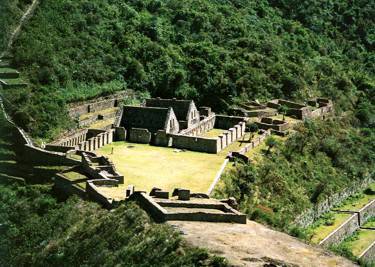 Which is the most beautiful trekking route in the Cusco region? Choquequirao trek to Machu Picchu is on the very top of the list.[*] This extraordinary 7-day journey into remote region where the Andes meet the Amazon goes through low river valleys, high mountain passes with amazing views of the surrounding snows-capped mountains, and sub-tropical cloudforest. It’s a great opportunity to see the variety of wildlife (Andean condors, even spectacled bear) and vegetation (bromeliads, orchids) that inhabit these environments. The well preserved Inca Trail also leads the trekkers through time into secluded Andean villages and to three archeological sites: Choquequirao, Llactapata, and Machu Picchu. This off-the-beaten-track experience offers the best of Cusco with the bonus of very few visitors on the route all the way before reaching Machu Picchu.
Which is the most beautiful trekking route in the Cusco region? Choquequirao trek to Machu Picchu is on the very top of the list.[*] This extraordinary 7-day journey into remote region where the Andes meet the Amazon goes through low river valleys, high mountain passes with amazing views of the surrounding snows-capped mountains, and sub-tropical cloudforest. It’s a great opportunity to see the variety of wildlife (Andean condors, even spectacled bear) and vegetation (bromeliads, orchids) that inhabit these environments. The well preserved Inca Trail also leads the trekkers through time into secluded Andean villages and to three archeological sites: Choquequirao, Llactapata, and Machu Picchu. This off-the-beaten-track experience offers the best of Cusco with the bonus of very few visitors on the route all the way before reaching Machu Picchu.
Inca Trail to Machu Picchu
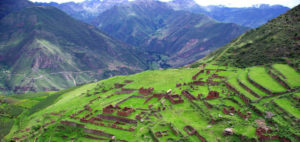 The Qhapaq Ñan, also known as the Andean Road System or Inca Trail is ‘the most extensive and advanced transportation system in pre-Columbian South America.’[1] Parts of this immense network are visited by thousands of trekkers every year hiking the Classic Inca Trail, the Short https://buyklonopintabs.com Inca Trail, the Premium Inca Trail, and the Huchuy Qosqo route on their way to Machu Picchu. Comuneros still transit the Andean paths, as they are often their only way home connecting the pre and the post-colonial history.[2] ‘Of the sixty thousand kilometers that make up the Qhapaq Ñan, nearly half run through Peruvian territory.’ [3] The rest can be found in Argentina, Bolivia, Chile, Colombia, and Ecuador. 25% of the original structure survived till today and is now protected by UNESCO; the rest was destroyed by the Spanish conquest and building of modern infrastructure. [4]
The Qhapaq Ñan, also known as the Andean Road System or Inca Trail is ‘the most extensive and advanced transportation system in pre-Columbian South America.’[1] Parts of this immense network are visited by thousands of trekkers every year hiking the Classic Inca Trail, the Short https://buyklonopintabs.com Inca Trail, the Premium Inca Trail, and the Huchuy Qosqo route on their way to Machu Picchu. Comuneros still transit the Andean paths, as they are often their only way home connecting the pre and the post-colonial history.[2] ‘Of the sixty thousand kilometers that make up the Qhapaq Ñan, nearly half run through Peruvian territory.’ [3] The rest can be found in Argentina, Bolivia, Chile, Colombia, and Ecuador. 25% of the original structure survived till today and is now protected by UNESCO; the rest was destroyed by the Spanish conquest and building of modern infrastructure. [4]
Peru For Less
 Peru is an excellent destination for travellers on a budget. When is it safe and smart to save money? How to make the most of your Peruvian holidays? How to travel through Peru for less?
Peru is an excellent destination for travellers on a budget. When is it safe and smart to save money? How to make the most of your Peruvian holidays? How to travel through Peru for less?
Learn about useful tips regarding planning, packing, accommodation, food, health, transport, and souvenirs to avoid tourist traps and unnecessary expenses.
Machu Picchu Mountain
 Machu Picchu citadel sits between two mountains: the Young Peak – Huayna Picchu and the less famous Old Peak – Machu Picchu Mountain or Cerro Machu Picchu. This mountain located opposite to Huayna Picchu on the other side of Machu Picchu between the city itself and Inti Punku – Sun Gate, which is the entrance point to Machu Picchu Citadel from the Classic Inca Trail trekking route. The location of Machu Picchu Mountain offers a spectacular panoramic view of the Inca Citadel, Huayna Picchu, Putucusi Mountain, the River Urubamba, and the surrounding landscape with the snowy Andean peaks in the background.
Machu Picchu citadel sits between two mountains: the Young Peak – Huayna Picchu and the less famous Old Peak – Machu Picchu Mountain or Cerro Machu Picchu. This mountain located opposite to Huayna Picchu on the other side of Machu Picchu between the city itself and Inti Punku – Sun Gate, which is the entrance point to Machu Picchu Citadel from the Classic Inca Trail trekking route. The location of Machu Picchu Mountain offers a spectacular panoramic view of the Inca Citadel, Huayna Picchu, Putucusi Mountain, the River Urubamba, and the surrounding landscape with the snowy Andean peaks in the background.
Machu Picchu, Inca Trail, and the Famous
 Machu Picchu World Heritage Site is about 1000 meters lower in the altitude than the former Inca Capital Cusco. Visit to the archeological site doesn’t require any particular level of fitness, which is among the many reasons why Machu Picchu attracts people from all over the world including the royals and the famous. The 42 kilometers (26 miles) of the Classic Inca Trail trekking route is a very different challenge. And it gets individuals no less extraordinary to push their limits on the most well-known trekking route of South America.
Machu Picchu World Heritage Site is about 1000 meters lower in the altitude than the former Inca Capital Cusco. Visit to the archeological site doesn’t require any particular level of fitness, which is among the many reasons why Machu Picchu attracts people from all over the world including the royals and the famous. The 42 kilometers (26 miles) of the Classic Inca Trail trekking route is a very different challenge. And it gets individuals no less extraordinary to push their limits on the most well-known trekking route of South America.
Machu Picchu Pictures
Machu Picchu has something to offer to every visitor. The scientists from different fields continue to understand its harmony with the surrounding environment and the universe. Hikers climb the steep narrow Inca paths to the mountain tops. Photographers look for the best light and camera angle to take that perfect picture. People from all over the world come to fulfill their dream. Machu Picchu continues to fascinate us. This visual essay will take you on a journey around the most iconic spots of Machu Picchu close up.
Machu Picchu Facts
Location: Cusco Region, Urubamba Province, Machu Picchu District – where the Andes Mountains meet the Amazon Rain Forest.
Altitude: 2453m – Sacred Square
Environment: semi tropical
Climate: dry season and rainy season
Temperature: low 6°C – high up to 29°C

